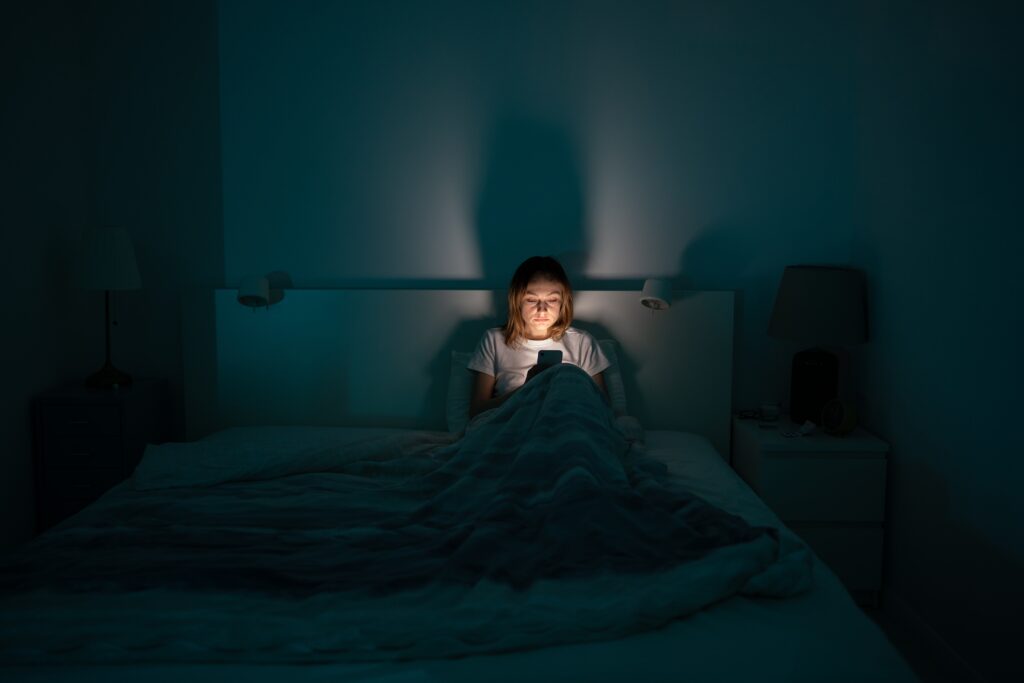Immediate Availability - Open 7 days a week - day, evening and weekend appointments
Immediate Availability - Open 7 days a week - day, evening and weekend appointments

A late-night scroll session watching friends’ highlight reels, perfect vacations, and smiling selfies can leave even the most connected person feeling strangely lonely. Despite its promise of connection, social media plays a role in the rising rates of anxiety and depression, particularly among young Canadians. But what’s really going on behind the screens? And what choices can help us protect our mental well-being?
Our daily use of platforms like Instagram, TikTok, and Snapchat has skyrocketed, and so too have worry-worthy trends in mental health. In this blog, we'll explore how social media can fuel negative emotions and thought patterns, especially in teens and young adults, and share practical tools that can help us reclaim healthier digital habits.
Over the past decade, Canadian teens have embraced social media in record numbers. A 2023 Statistics Canada report found that adolescents spending over three hours a day on social media were significantly more likely to report poor mental health outcomes, almost twice the rate of their lower-use peers (Statistics Canada, 2023). Meanwhile, the Public Health Agency of Canada has reported a consistent upward trend in depression and anxiety symptoms among Canadian youth, aligning with increased social media use (Public Health Agency of Canada 2023).
Though correlation doesn’t always mean causation, multiple longitudinal studies in Canada point to a striking pattern: when screen use climbs, emotional struggles often follow. For example, a 2022 study of high school students documented co-occurring patterns of internet addiction and negative emotional symptoms over a school year (Gao et al., 2022). Another longitudinal Quebec study found that heavier digital media exposure was linked with psychotic-like experiences and depressive symptoms in young adults (Paquin et al., 2023). These trends set the stage for understanding how our screen habits might be affecting our mental health.
Let’s explore the mechanisms linking our phone habits to feeling down. Canadian research highlights some key pathways: comparison culture, FOMO (Fear of Missing Out), cyberbullying, addictive dopamine feedback, and sleep disruption.
Scrolling feeds curated to perfection distorts our perception of reality and our own sense of worth. A study conducted in Quebec found that female adolescent internet use was a predictor of higher depressive symptoms over time, compared to peers who used the internet less (Fitzpatrick et al. 2023). In a world of curated selfies and perfect captions, it’s easy for girls to lose sight of their own worth behind the scroll.
Our self-esteem counselling supports individuals working through these internal narratives.
Constant exposure to friends’ escapades can deepen feelings of exclusion. The more we watch others’ curated lives, the more we may feel left out of our own. Research shows that these feelings, often referred to as FOMO, are more than just social buzz. They're tied to real emotional distress, especially among adolescents and young adults navigating identity and belonging. One study found that reducing time spent on social media significantly lowered reported feelings of FOMO and loneliness (Hunt et al., 2018).
The shield of anonymity on social platforms can lead to sharp emotional blows. Cyberbullying is all too common. Studies show that youth facing digital harassment report more intense depression and social withdrawal. The consequences of a hateful comment can linger far longer than the original post.
Social media is designed to stimulate short bursts of validation through likes and comments, which may not sustain long-term emotional well-being. Canadian young adults who primarily engaged in passive social media use—scrolling and consuming without interaction—reported significantly higher depressive symptoms compared to peers in other use-pattern groups (Miconi et al., 2024).

Late-night screen time isn’t just a habit; it’s a known disruptor of sleep and emotional regulation. Blue light delays melatonin release, and the emotional stimulation of scrolling through feeds can leave the brain overstimulated at bedtime. While the relationship between screen use and sleep isn’t always straightforward, research shows that high levels of digital engagement are associated with both poor sleep quality and emotional distress in teens.
A 2023 Public Health Agency of Canada report linked problematic social media use among Canadian adolescents to inadequate sleep and increased mental health symptoms (Public Health Agency of Canada, 2023).
Not everyone is impacted equally by social media. Canadian research points to several groups that may be more susceptible to its negative mental health effects:
If any of these sound familiar to you or someone you care about, it could be worth pausing to examine the emotional impact of your digital habits.
You don't need a diagnosis to start paying attention. Here are clear signs that your scrolling might be leaving a mark:
Those feelings matter. If you’re relating to more than one, it might be a sign to shift gears.

Thankfully, change is within reach. Here are practical steps, backed by research, to reclaim your digital balance.
Even a short break can make a difference. In a randomized trial, young adults who reduced their social media use to 30 minutes per day for three weeks reported measurable improvements in both mood and emotional well-being (Hunt et al., 2018). The results highlight how even modest digital boundaries can help restore balance, without needing to swear off social media altogether.
Reduce digital noise by unfollowing accounts that trigger negative comparisons or anxiety. Replace them with creators who share real-life, unfiltered moments. A supportive feed can rewire our perceptions and restore connection.
Do something nourishing instead: go for a walk, write in a journal, cook a meal, or call someone. Even brief mindful actions can shift your emotional trajectory, turning doom-scrolling into self-care.
Sometimes digital habits are a symptom of deeper struggles. Therapy can help. At One Life, our depression and CBT therapy sessions support clients in reshaping comparison-driven thinking, rebuilding self-esteem, and crafting manageable digital habits.
Therapy isn’t about eliminating screens, it’s about understanding your inner dynamics around them and building emotional well-being.
Mental health professionals widely agree that early intervention can help prevent long-term impacts, whether the stress comes from screen time, relationships, or internal pressures. At One Life, therapy is a collaborative journey to rediscover yourself.
Social media isn’t going anywhere, and it doesn’t have to be the enemy. But when our phone habits leave us drained, anxious, or disconnected, it’s worth pausing. Does your screen time energize or erode you?
Your digital life should serve you—not steal your sense of self-worth. If social media feels more like a trigger than a tool, we’d love to help you navigate that balance. Choosing to step back from social media isn’t about missing out; it’s about reclaiming time, presence, and connection in the real world. Even if it means going against the grain, building a meaningful life offline is not only possible, it’s powerful. Reach out today.
While it doesn’t “cause” depression outright, Canadian studies show strong links,especially among teens using screens for hours daily.
Watch for low mood after scrolling, increased anxiety, sleep disruption, and obsessive checking. These are clear red flags.
Not necessarily. Boundaries, feed curation, and mindful breaks can often help more sustainably than quitting cold turkey.
Platforms prioritizing image perfection—like Instagram or TikTok—may trigger more comparison. Studies on these show heightened emotional instability in some users. (Hendrikse and Limniou, 2024)
Yes. Therapy helps shift negative thinking, restore self-esteem, and build healthy habits around screens.
If your teen shows mood changes, social withdrawal, or sleep problems tied to screen use, it’s time to address it. Youth counselling can be a powerful resource.
Fitzpatrick, C., Lemieux, A., Smith, J., West, G. L., Bohbot, V., & Asbridge, M. (2023). Is adolescent internet use a risk factor for the development of depression symptoms or vice-versa? Psychological Medicine, 53(14), 6773–6779. https://doi.org/10.1017/S0033291723000284
Gao, T., Liang, L., Li, M., Su, Y., Mei, S., Zhou, C., & Meng, X. (2022). Changes in the comorbidity patterns of negative emotional symptoms and Internet addiction over time among the first-year senior high school students: A one-year longitudinal study. Journal of Psychiatric Research, 155, 137–145. https://doi.org/10.1016/j.jpsychires.2022.08.020
Hunt, M. G., Marx, R., Lipson, C., & Young, J. (2018). No more FOMO: Limiting social media decreases loneliness and depression. Journal of Social and Clinical Psychology, 37(10), 751–768. https://doi.org/10.1521/jscp.2018.37.10.751
Kerr, S., & Kingsbury, M. (2023, February 15). Online digital media use and adolescent mental health. Statistics Canada. https://www150.statcan.gc.ca/n1/pub/82-003-x/2023002/article/00002-eng.htm
Miconi, D., Santavicca, T., Frounfelker, R.L. et al. Digital media use, depressive symptoms and support for violent radicalization among young Canadians: a latent profile analysis. BMC Psychology 12, 260 (2024). https://doi.org/10.1186/s40359-024-01739-0
Paquin, V., Philippe, F. L., Shannon, H., Guimond, S., Ouellet-Morin, I., & Geoffroy, M.-C. (2024). Associations between digital media use and psychotic experiences in young adults of Quebec, Canada: A longitudinal study. Social Psychiatry and Psychiatric Epidemiology, 59(1), 65–75. https://doi.org/10.1007/s00127-023-02537-6
Public Health Agency of Canada. (2023, February 21). Mental health and problematic social media use in Canadian adolescents. Government of Canada. https://www.canada.ca/en/public-health/services/publications/science-research-data/mental-health-problematic-social-media-use-canadian-adolescents.html
